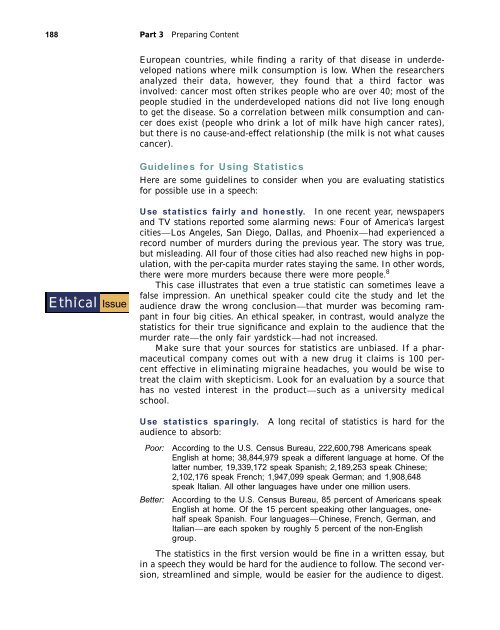Nurul Izzah Anwar, an engineering major at a college in Malaysia ...
Nurul Izzah Anwar, an engineering major at a college in Malaysia ...
Nurul Izzah Anwar, an engineering major at a college in Malaysia ...
Create successful ePaper yourself
Turn your PDF publications into a flip-book with our unique Google optimized e-Paper software.
188 Part 3 Prepar<strong>in</strong>g Content<br />
Ethical Issue<br />
Europe<strong>an</strong> countries, while f<strong>in</strong>d<strong>in</strong>g a rarity of th<strong>at</strong> disease <strong>in</strong> underdeveloped<br />
n<strong>at</strong>ions where milk consumption is low. When the researchers<br />
<strong>an</strong>alyzed their d<strong>at</strong>a, however, they found th<strong>at</strong> a third factor was<br />
<strong>in</strong>volved: c<strong>an</strong>cer most often strikes people who are over 40; most of the<br />
people studied <strong>in</strong> the underdeveloped n<strong>at</strong>ions did not live long enough<br />
to get the disease. So a correl<strong>at</strong>ion between milk consumption <strong>an</strong>d c<strong>an</strong>cer<br />
does exist (people who dr<strong>in</strong>k a lot of milk have high c<strong>an</strong>cer r<strong>at</strong>es),<br />
but there is no cause-<strong>an</strong>d-effect rel<strong>at</strong>ionship (the milk is not wh<strong>at</strong> causes<br />
c<strong>an</strong>cer).<br />
Guidel<strong>in</strong>es for Us<strong>in</strong>g St<strong>at</strong>istics<br />
Here are some guidel<strong>in</strong>es to consider when you are evalu<strong>at</strong><strong>in</strong>g st<strong>at</strong>istics<br />
for possible use <strong>in</strong> a speech:<br />
Use st<strong>at</strong>istics fairly <strong>an</strong>d honestly. In one recent year, newspapers<br />
<strong>an</strong>d TV st<strong>at</strong>ions reported some alarm<strong>in</strong>g news: Four of America’s largest<br />
cities—Los Angeles, S<strong>an</strong> Diego, Dallas, <strong>an</strong>d Phoenix—had experienced a<br />
record number of murders dur<strong>in</strong>g the previous year. The story was true,<br />
but mislead<strong>in</strong>g. All four of those cities had also reached new highs <strong>in</strong> popul<strong>at</strong>ion,<br />
with the per-capita murder r<strong>at</strong>es stay<strong>in</strong>g the same. In other words,<br />
there were more murders because there were more people. 8<br />
This case illustr<strong>at</strong>es th<strong>at</strong> even a true st<strong>at</strong>istic c<strong>an</strong> sometimes leave a<br />
false impression. An unethical speaker could cite the study <strong>an</strong>d let the<br />
audience draw the wrong conclusion—th<strong>at</strong> murder was becom<strong>in</strong>g ramp<strong>an</strong>t<br />
<strong>in</strong> four big cities. An ethical speaker, <strong>in</strong> contrast, would <strong>an</strong>alyze the<br />
st<strong>at</strong>istics for their true signific<strong>an</strong>ce <strong>an</strong>d expla<strong>in</strong> to the audience th<strong>at</strong> the<br />
murder r<strong>at</strong>e—the only fair yardstick—had not <strong>in</strong>creased.<br />
Make sure th<strong>at</strong> your sources for st<strong>at</strong>istics are unbiased. If a pharmaceutical<br />
comp<strong>an</strong>y comes out with a new drug it claims is 100 percent<br />
effective <strong>in</strong> elim<strong>in</strong><strong>at</strong><strong>in</strong>g migra<strong>in</strong>e headaches, you would be wise to<br />
tre<strong>at</strong> the claim with skepticism. Look for <strong>an</strong> evalu<strong>at</strong>ion by a source th<strong>at</strong><br />
has no vested <strong>in</strong>terest <strong>in</strong> the product—such as a university medical<br />
school.<br />
Use st<strong>at</strong>istics spar<strong>in</strong>gly. A long recital of st<strong>at</strong>istics is hard for the<br />
audience to absorb:<br />
Poor: Accord<strong>in</strong>g to the U.S. Census Bureau, 222,600,798 Americ<strong>an</strong>s speak<br />
English <strong>at</strong> home; 38,844,979 speak a different l<strong>an</strong>guage <strong>at</strong> home. Of the<br />
l<strong>at</strong>ter number, 19,339,172 speak Sp<strong>an</strong>ish; 2,189,253 speak Ch<strong>in</strong>ese;<br />
2,102,176 speak French; 1,947,099 speak Germ<strong>an</strong>; <strong>an</strong>d 1,908,648<br />
speak Itali<strong>an</strong>. All other l<strong>an</strong>guages have under one million users.<br />
Better: Accord<strong>in</strong>g to the U.S. Census Bureau, 85 percent of Americ<strong>an</strong>s speak<br />
English <strong>at</strong> home. Of the 15 percent speak<strong>in</strong>g other l<strong>an</strong>guages, onehalf<br />
speak Sp<strong>an</strong>ish. Four l<strong>an</strong>guages—Ch<strong>in</strong>ese, French, Germ<strong>an</strong>, <strong>an</strong>d<br />
Itali<strong>an</strong>—are each spoken by roughly 5 percent of the non-English<br />
group.<br />
The st<strong>at</strong>istics <strong>in</strong> the first version would be f<strong>in</strong>e <strong>in</strong> a written essay, but<br />
<strong>in</strong> a speech they would be hard for the audience to follow. The second version,<br />
streaml<strong>in</strong>ed <strong>an</strong>d simple, would be easier for the audience to digest.

















